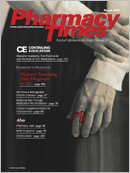Publication
Article
Pharmacy Times
Weighing Benefit and Risk When the Risk Is Uncertain
In an ideal world, for each drug-druginteraction, we would know howoften patients are harmed by theinteraction, what factors increase therisk of harm and by how much, and howthe risk escalates when the patient hasmultiple risk factors. Ideally, we alsowould know how much we reduce therisk to the patient if we use an alternativedrug for one of the interacting drugs.
Unfortunately, for the vast majority ofdrug interactions, we have little informationon these questions. Indeed, one ofthe central problems in managingdrug-drug interactions is the lack of epidemiologicinformation on how oftenpatients are harmed by a particulardrug-drug interaction. Most drug-druginteractions are based on isolated casereports and/or pharmacokinetic studiesin healthy subjects; thus, we can usuallyonly indirectly assess the risk of the interactionin any particular patient.
So, how do we make decisions whenwe are alerted to a potentially dangerousdrug interaction? Well, we do the bestwe can with the available information byasking ourselves the following questions.
Are Both Drugs Truly Necessaryfor This Patient?
This is probably the first question thatshould be asked. It is not unusual for one(or sometimes both) of the interactingdrugs to be of questionable value for thepatient. For example, in a patient withParkinson's disease taking a monoamineoxidase A (MAO-A) inhibitor such asrasagiline or selegiline, how necessary isdextromethorphan if the patient developsa cough? Dextromethorphan generallyhas only a modest therapeutic benefitfor coughs, and, even though the riskof giving dextromethorphan with MAO-Ainhibitors is probably low, it would beprudent to avoid the combination.
Is This Patient at Risk?
If one of the drugs cannot be deemedunnecessary, we must then attempt toassess the risk of the interaction to thepatient. For a small number of drug interactions,the risk of serious adverse consequencesis so high that no patientshould receive the combination. Theseinteractions are easy to manage, but theyalso are rare. For some other interactions,the primary risk factors are known.For example, the concurrent use of anangiotensin-converting enzyme inhibitorand a potassium-sparing diuretic is muchmore likely to result in life-threateninghyperkalemia in an elderly diabetic withrenal impairment. For other interactions,risk factors such as dose and duration ofthe drugs, pharmacogenetic factors, andunderlying diseases can increase ordecrease the risk.
For most drug interactions, however,only limited data are available regardingrisk factors, and we are left with findingan approximate solution to the problemusing the available (insufficient) information.At this point, the process becomesvery particular to the patient in question,and we must consider all of the pertinentdata on the drug interaction in light of allof the patient information.
What Is the Optimal Managementfor This Patient?
If the patient is considered to be at sufficientrisk to take some sort of action,we must settle on a management plan tominimize the risk. This usually takes theform of one or more of the following:
1. Selecting a noninteracting (or lesserinteracting) drug to replace one ofthe interacting drugs
2. Monitoring for evidence of the interaction(eg, signs, symptoms, laboratorytests), so that it may be detectedquickly and appropriate changesmade, such as dose adjustments ordiscontinuation of one or both of thedrugs
3. Reducing the risk of an adverse consequenceby making prophylacticdosage adjustments, temporarilystopping one of the drugs, or separatingdoses (in the case of gastrointestinalabsorption drug interactions)
Conclusion
For the vast majority of drug-druginteractions, the pharmacist is calledupon to make decisions based on lessthan optimal information. This is simplythe state of knowledge in drug interactionstoday (and for the foreseeablefuture). Nonetheless, ignoring the interactionis not an option, because some ofthem do indeed represent a danger tothe patient. So we must take the bestavailable information and make the bestdecision we can.
Drs. Horn and Hansten are both professorsof pharmacy at the Universityof Washington School of Pharmacy.For an electronic version of this article,including references if any, visitwww.hanstenandhorn.com.







